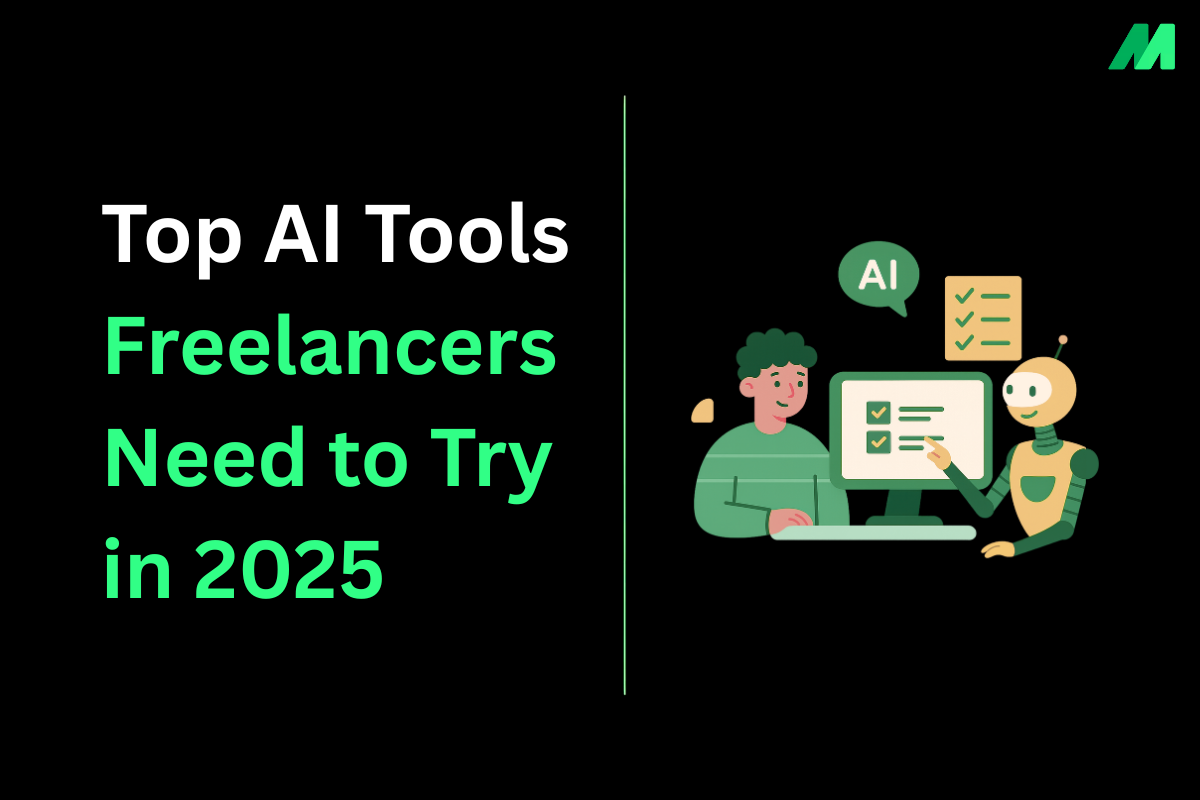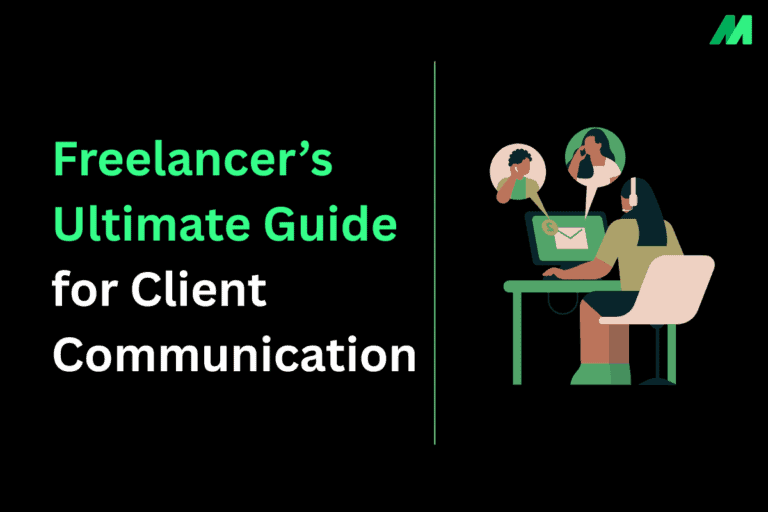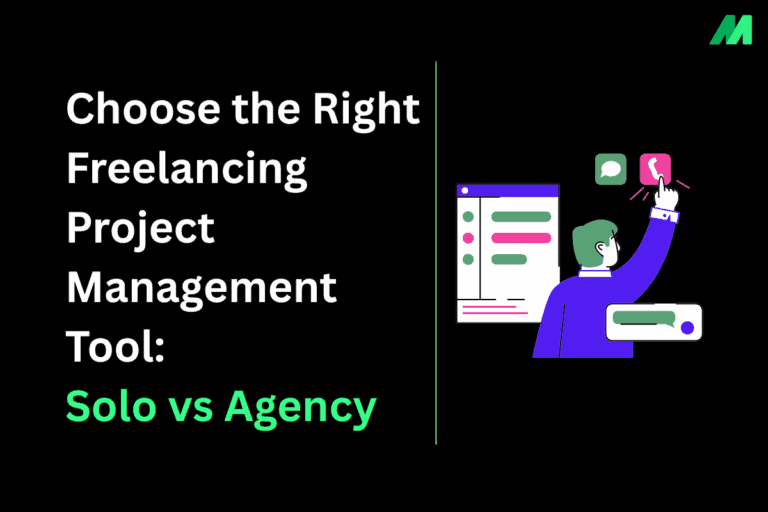Freelancing comes with a lot of freedom; you can select your clients, work on your schedule, and do it from anywhere. The downside is that the freedom can be stressful. Transitioning from client to client and project to project, reminding clients to pay you, and still trying to give quality work, freelancers are stretched thin.
Fortunately, AI tools are leading freelancers into the future. They are not new inventions of the future, but current amenities that are helping freelancers reduce repetitive tasks, streamline client communication, and shift their focus to creative work. Knowing the right AI tools in 2025 can determine if you hit burnout again or achieve balance.
AI Tools for Freelancers in 2025: Comparison Table
| Category | Tool | What It Does | Payment Model | Pricing (as of 2025) |
| AI Writing Assistants | ChatGPT | Brainstorming, drafting blogs, proposals, and client emails | Freemium | Free GPT-3.5; GPT-4 $20/mo |
| Jasper AI | Marketing copy, branded content, ad campaigns | Subscription | From $39/mo | |
| Copy.ai | Quick captions, social posts, campaign content | Credit-Based | Credit packs or subscription | |
| AI Design Tools | Canva AI | Social posts, presentations, logos | Freemium | Free plan; Pro $12.99/mo |
| Adobe Firefly | Generative design, image editing | Credit-Based | Uses Generative Credits (included in Adobe plans) | |
| AI Project Management | Notion AI | Summarizes notes, project briefs, docs | Subscription | $8/mo add-on (annual billing) |
| ClickUp AI | Task priorities, workflows, meeting notes | Tiered Pricing | Free basic; $7-12/mo for advanced | |
| Motion | Auto-schedules tasks around meetings | Subscription | ~$34/mo billed annually | |
| AI Communication Tools | Otter.ai | Real-time transcription, meeting notes | Credit-Based | Free 300 min/mo; paid from $10/mo |
| DeepL | High-quality translations | Subscription | Free limited; Pro from ~$8/mo | |
| Grammarly | Grammar, tone, clarity checks | Freemium | Free basic; Premium from $12/mo | |
| AI Finance & Admin | Bonsai | Contracts, proposals, invoicing | Tiered Pricing | $25-79/mo |
| AgreementGen | AI-generated contracts | Subscription | Custom plans (varies) | |
| AI Invoicing Apps (e.g., Wave, Zoho Invoice) | Auto-generate invoices, send reminders | Freemium / Tiered | Free basic; paid upgrades | |
| Team / Enterprise | Slack (with AI integrations) | Team chat, workflows, AI summaries | Enterprise / Subscription | From $7.25/mo per user |
| Adobe Creative Cloud | Full suite w/ Firefly AI | Enterprise | Team pricing, varies by plan |
Quick Takeaways for Freelancers:
- Start Free: Tools like ChatGPT, Canva AI, and Grammarly cover most basics at no cost.
- Upgrade Smartly: If a tool directly helps you land clients (e.g., Jasper for branded content), reinvest earnings to go Pro.
- Mix Models: Use subscription tools for daily work (Notion, Motion), and credit-based tools (Otter, Firefly) for occasional needs.
What Makes a Good AI Tool for Freelancers
With many AI tools arriving every week, it can be overwhelming. Not every tool will fit into your workflow, so here are characteristics to look for:
1. Time-Saving Automation
What it means: The tool should reduce redundant, time-consuming work to free you up for high-value work.
Why it is important for freelancers: Time is money. Every hour you spend transcribing meetings, drafting emails, or scheduling is one less hour earned.
Examples:
- Drafting: Rather than working through 10 variations of a proposal for your client, a tool like Chat GPT or Upwork’s Uma can draft several proposals for you in seconds.
- Transcribing: Rather than needing to type out your meeting notes, a site like Otter.ai can automatically transcribe and summarize the call.
- Scheduling: Tools like Motion take care of autorescheduling your calendar, based on the deadline and your availability.
Imagine finishing a 1-hour meeting and immediately action items are written down for you without you lifting a finger- that is time-saving automating.
2. Integration-Friendly
What it means: The AI tool should connect well to your already existing way of working; apps you already use for writing, communication, project management, or design.
Why it matters for freelancers: Switching between too many apps wastes time, and if an AI tool connects with existing apps/tools you’re already using, this means that information stays in one place.
Examples:
- Slack + otter.ai: Have a transcript of a meeting sent automatically to your Slack channel.
- Notion AI: keep your notes, tasks, and client briefs all in Notion, rather than bouncing between Google Docs + Trello.
- Canva AI + Dropbox: auto-save generated designs directly into shared folders with clients.
If you use Google Docs, then an AI that works in Docs directly is better than one that uses a separate app.
3. Ease of Use
What it means: The software should be easy to use, natural, and offer useful instructions for novice users.
Why it’s important for freelancers: Not everyone is a tech whiz, and learning new software takes time, and we all know clients don’t pay us to learn software.
Examples:
- Grammarly AI can work as a browser plugin, and they don’t expect you to learn a new platform.
- Canva AI has prompts such as “Make a modern resume design,” so you don’t need to have a design degree to accomplish the task.
- Tools that have dashboards that look similar to tools you use at your main platform (Docs, Sheets, Calendars, etc.) are generally easier to navigate with similar action buttons to learn.
If it takes you days to understand a tool, you are working at a revolved gear and are slower, not faster.
4. Fair Pricing
What this means: There should be a free or low-cost plan, and upgrades happen when you really need advanced features.
Why it matters to you: Your budget is not the same as the next freelancer’s. If the average monthly cost of the tools you need is $50 and you are getting started, it may be hard to manage your profits to pay for multiple tools over time.
Examples:
- Some examples of tools that have free versions and do amazing work for daily tasks include ChatGPT, Grammarly, and Canva.
- Other tools, like Jasper AI, may charge higher prices, but might give you back a lot in the way of content writing volume that you do.
- Smart freelancers will test tools using free tiers, and only upgrade if the ROI is clear (time saved or extra projects bought).
When thinking about tools and pricing, use the mindset of an investment; if a tool is $20 a month and helps you secure a $200 project, it was worth it.
5. Customizability
What it means: AI needs to allow you to adjust how it conveys whatever it generates to match your unique style, brand, or tone.
Why it matters to freelancers: Clients choose to work with you based on your voice and creativity. If AI outputs sound like a robot or generic versions of your voice, your value is lost.
Examples:
- ChatGPT can be “trained” with your tone (e.g., casual, formal, witty).
- Jasper AI allows you to set a “brand voice” for all content.
- Notion AI summaries can be rewritten in different tones (“professional” vs “friendly”).
A proposal generated by AI should sound like you, not like a template from a machine.
6. Data Privacy
What this means: The product should clearly indicate how it will safeguard your information, and you need to be able to know who owns the outputs.
Why it matters to freelancers: Typically, client work deals with sensitive information. If you are using a product that is not safe to work with, you could risk a breach or even legal problems!
Examples:
- Upwork’s Uma indicates its privacy protections that ensure freelancer-client information stays private.
- Some products store all prompts and use them for training models. This may not be a concern for general use, but it could be problematic when working on client work that is meant to be private.
- As a general rule, check to see if you have ownership of the outputs generated by text, design, or code, etc.
Again, if you are writing a confidential business plan for a client, you wouldn’t want that model to use those prompts for another client.
Top AI Tools for Freelancers in 2025
Let’s categorize the must-try AI tools to help you decide which fit your freelance business best.
1. AI Writing Assistants
- ChatGPT – Great for brainstorming, drafting blogs, proposals, or client emails.
- Jasper – Tailored for marketers, ad copy, and branded content.
- Copy.ai – Quick social media captions and campaign content.
Instead of taking an hour to write a technical proposal for a new client, you can use ChatGPT and ask, “Write a friendly proposal for a new client for a social media campaign with goals, a timeline, and deliverables.” With limited editing, you would have your proposal done in minutes.
2. AI Design Tools
- Canva AI – Generate social posts, presentations, and logos quickly.
- Adobe Firefly – Professional-grade generative design and image editing.
Example: Do you need an Instagram graphic but don’t have time to create one? You can go to Canva, use their AI tool, and type in, “Create a minimalist quote graphic with a pastel background.” The graphic will be ready instantly, and you can tweak the design.
3. AI Project Management Tools
- Notion AI – Summarizes notes, organizes project briefs, and keeps knowledge searchable.
- ClickUp AI – Suggests task priorities, writes meeting notes, and streamlines workflows.
- Motion – Automatically schedules tasks around meetings and deadlines.
Example: Instead of blocking your calendar for your meetings and deadlines, you can let Motion plan your calendar for the week for you, just like a really smart personal assistant would.
4. AI Communication Tools
- Otter.ai – Real-time meeting transcription and summaries.
- DeepL – High-quality translation for global clients.
- Grammarly – Polishes grammar, tone, and clarity in emails or reports.
Sample: After a 1-hour client call, Otter will produce a transcript and action item list so you do not need to write detailed notes.
5. AI Finance & Admin Tools
- Bonsai – Contracts, proposals, invoicing. All in one.
- AgreementGen – Drafts professional contracts tailored to freelancers.
- AI-Powered Invoicing Apps – Auto-generate invoices and send reminders.
Sample: Instead of invoicing by hand, Bonsai sends manual reminders for invoices, allowing you to concentrate on client work.
Payment Models of AI Tools for Freelancers
Freelancers often worry about affordability. The good news is that most AI tools follow clear pricing structures designed to fit different stages of your career. Here’s a breakdown:
| Model | How It Works | Why Freelancers Like It | Examples | Best For |
| Freemium (Free + Paid Upgrade) | Free basic features; pay for advanced options | Test tools before investing | ChatGPT (Free / $20/mo), Canva AI (Free / $12.99/mo), Grammarly (Free / $12/mo) | Beginners experimenting with AI |
| Subscription (Monthly / Yearly) | Fixed fee for unlimited or capped use | Predictable cost, easy to budget | Jasper ($39/mo), Notion AI ($8/mo), Motion ($34/mo) | Full-time freelancers need reliability |
| Credit-Based / Pay-as-You-Go | Buy credits; pay per use | No lock-in, flexible spending | Copy.ai, Otter.ai, Adobe Firefly | Part-time or seasonal freelancers |
| Tiered Pricing (Starter → Pro → Business) | Different plans unlock more features | Scale gradually as business grows | Bonsai ($25-79/mo), ClickUp (Free / $7-12/mo) | Growing freelancers scaling up |
| Enterprise / Team | Custom plans for teams/agencies | Suits collaboration and scaling | Slack ($7.25+/user), Adobe Creative Cloud | Freelancers expanding into agencies |
Pro Tip for Freelancers
- Begin by always using free tiers to test the workflow.
- When you receive a client due to a specific tool (such as a design within Canva Pro, or a blog draft via Jasper AI), use a portion of that income to upgrade.
- Also, a lot of “free” tools have limits hidden in the fine print, which include word count, amount of storage, or credits.
Beginner’s Guide: How to Start Using AI as a Freelancer
If you’re new to AI tools, don’t try to master everything at once. Here’s a simple roadmap:
- Select one pain point – What do you find most draining? Writing, a lot of admin, and project management are worth exploring.
- Select one tool – If it is writing, you can try out ChatGPT. If it is an admin, you can try using a tool like Bonsai.
- Start with lower risk tasks – Draft an email, create a design mockup, or transcribe a meeting.
- Refine the tool with your own unique voice – AI will provide a draft, but you will inject authenticity.
- Quantify your results – Track the time you save using each tool and whether your efficiency improves.
- Amplify – Once the first one begins to click, you can start implementing a second one into your workflow.
Example Workflow: A Freelancer’s Day With AI
Let’s imagine a content creator’s day with AI tools:
- Morning: Place the client brief into Notion AI and generate a project summary.
- Mid-morning: Utilize ChatGPT to draft a blog outline and fine-tune it.
- Afternoon: Develop matching social media graphics with Canva AI.
- Client call: Allow Otter.ai to compose a transcription and find the action points.
- Evening: Track hours and send invoices using Bonsai.
What did we achieve? A day that didn’t involve all of the administration work eating into our creativity.
Tips & Best Practices for AI Success
- Be true to yourself – Always adjust the drafts from AI to match your style or to show your original voice.
- Update your clients – Some like to know you use AI, while others prefer not to know. Be honest, if you have to or want to lean on AI.
- Limit AI tools – Stick to 2-3 AI tools that are actually helpful. Too many will slow you down.
- Be mindful of your budget – Start with free plans. Don’t upgrade unless you anticipate a decent return on your investment.
- Secure data – Use only reliable tools with good privacy policies.
Final Thoughts: Freelancing Smarter in 2025
AI is not meant to take the place of freelancers. It is meant to help freelancers. The right tools will help you:
✅ Save time on repetitive tasks
✅ Get polished projects done more repeatedly
✅ Communicate with your clients about the service you are providing
✅ Spend more time working on creative and strategic work
The goal is to start small and work up to a fuller AI-identified process. Outperform by 2025 those freelancers who are working faster, thanks to AI, or positioning themselves for a more competitive future within the context of their freelance practices.
So, if freelancing is sometimes overwhelming – let AI do the heavy lifting, so you can do what you do best.




